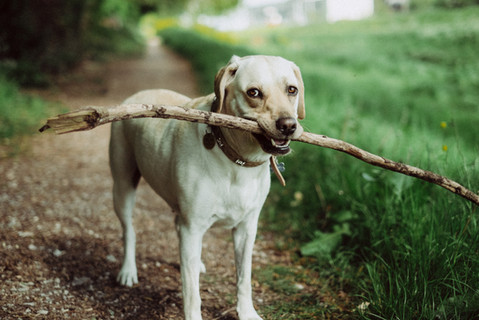How to Find a Lost Pet
- Morgan McKibbon
- Oct 29, 2018
- 6 min read
When I was fifteen years old my childhood dog, Fella, went missing. I don’t remember the circumstances that led to his disappearance but I do remember feeling overwhelmed with sadness and desperation to have him back. I wondered how everyone else could go on living their lives when all I could think about was finding Fella. My mom and I made dozens of flyers and plastered them all over the neighborhood. Thankfully, this story has a happy ending and one week later Fella was back home after being returned by a woman who found him.
Unfortunately, my happy ending is not what always happens. In fact, a study funded by the ASPCA and published in 2012 found that 7% of dogs and 25% of cats that are lost are never reunited with the owners who lost them. Those percentages may seem low but the numbers translate to 766,360 dogs and 3,240,000 cats that are lost every year and are NOT reunited with their owners.
Preventive Measures
It is important to have a plan in mind for if, and when, a pet is lost. But before that happens, it’s just as important to prevent a loss in the first place. Consider these ideas:
1. Mend your fences.
Fences present not just a risk for digging under or squeezing through but also for jumping over. Two years ago a client of mine moved into a new home with a 6’ fence, fully intending to replace it with an 8’ fence. Unfortunately, before that happened, two weeks after moving in his Springer Spaniel jumped over the fence and died after being hit by a car. If should go without saying, but I’ll say it anyway: if there is any risk of your dog getting out of your yard because it is not secure, all time outside should be supervised until the fence can be repaired.
2. Beware of open doors.
I hear over and over, and over, via posts on Facebook, NextDoor and from my clients and friends that their pets get lost because someone who was working or visiting their home let a pet out accidentally. This is especially true for cats. It is definitely worth telling those who do not live in your home to be aware of your pets and careful not to let them out.

3. Practice your recall.
Trainers use the term recall to refer to getting your dog to come when called. Working with your dog to practice recall can go a long way toward keeping your dog from running away once it is out the door. There are many articles and videos online that can provide great information on training for perfect recall.
A special note about cats: The decision to keep a cat indoors 100% of the time versus having an indoor/outdoor kitty or an always-outdoor kitty should not be made lightly. Regardless of whether you feel that cats are a threat to birds, rodents, etc., there is real danger to cats from snakes, coyotes, birds of prey, dogs, cars and people. It’s a sad reality that every day cats (and dogs) are targeted by malicious people who intentionally injure or even kill them. I urge you to keep your cats indoors at all times and your dogs indoors except for potty breaks.
Go On The Offensive
While these suggestions are very important, let’s face it - your dogs and cats may still get lost. When that happens your best defense is a good offense. Make sure that your pet can be easily identified by considering some, or all, of these options.
1. Collars and tags for cats
Collars are easier for dogs which likely accounts for the much higher percentage of dogs versus cats being reunited with their owners. Some cats don’t tolerate wearing tags but for those that do it can be the first sign to alerting someone that a cat they’re seeing is not supposed to be outside. Any collar with a small tag that says “I’m lost” and includes a phone number will do but you can make it even better by dressing a cat as an escaped convict with an orange collar. See www.kittyconvict.com for more information on this program.
2. Collars and tags for dogs
There is a wide and diverse range of options for dogs when it comes to collars and tags. Having a rabies tag is sometimes enough if a person knows to call the animal shelter to get the owner’s name. Even better, though, is to have a tag that specifically states a name and phone number to call. Or, take it a step further, and use a cheeky message like “Call my mom before she freaks out!”
3. Microchips
While collars and tags should be considered the most important method of identification for your pet, not all pet owners keep collars on at all times, particularly when at home. Should your pet get lost without its collar, a microchip can be, literally, a life-saver. But there are a few things to keep in mind about microchips.
As with any technology, microchips are not perfect. Many companies manufacture microchips but they don’t all use the same radio-frequency and, although each also manufactures universal scanners, a study in 2009 showed that even the best scanner was effective only around 98% of the time. To be sure, these are good odds, but to ensure the best results choose an ISO-compliant nano chip that is injected in front of the shoulder blade, says Dr. Leigh Anne Robertson at Lantana Animal Hospital. These chips are implanted using a smaller needle than traditional microchips, are less likely to migrate, and meet the standards required in countries such as Canada, Europe, Australia and some Asian countries.
Before implantation your vet should first scan your pet to see if it already has a chip. This is especially important for dogs and cats adopted from animal shelters and rescue organizations so that, if your pet is lost, you can be sure that the information gleaned from a scanned chip is correct. After implantation, your vet should scan again to be sure that it transmits to the scanner properly.
The most important step to take with microchips of any kind is to complete the registration. When you have a microchip implanted in your pet, or if you adopt a pet that already has a microchip, go home and immediately register it with the manufacturer. You can also add your pet’s microchip and contact information with online registries such asFoundAnimals.org and FreePetChipRegistry.com. Keep your registration information in an easy-to-find place and update it every year and/or every time your contact information changes.
4. GPS trackers
GPS trackers for pets used to be prohibitively expensive; however, several companies have come out recently with viable options at reasonable costs. Some charge a monthly fee and other don’t. Be sure to research the features to pick the best option for your pet and your budget. Some companies to look at are Tractive, Findster and Whistle.
When All Else Fails
My posting signs everywhere was the key to getting my Fella back but sometimes that will not be enough. In fact, in some areas, particularly HOAs, it it not even allowed. To pull out all the stops take the following steps.
1. Flyers
Wherever possible, plaster your neighborhood with signs that include your pet’s picture, any distinguishing marks and several methods of contacting you. If you are offering a reward, be sure to include that information as well.
2. Animal shelters and pet-related businesses
Dogs and cats have been known to travel many miles away from where they were lost. In fact, the ASPCA recommends that you notify every animal shelter within a 60 mile radius of where your pet was lost. You should also post signs with veterinarians, groomers, pet stores and pet boarding locations. Start with those in your area and work your way out from there. For a list of local pet-related businesses, start here: www.pinkpawpetsitting.com/lostpets.
3. Social Media
If you are not yet a member of NextDoor.com you should consider becoming one as soon as possible. NextDoor is a social media site that connects neighbors within a small geographical area. Profiles and posts are visible only by those in your area. It allows you to post an Urgent Alert which immediately alerts those in your neighborhood to be on the lookout for your pet. There are also several local groups and pages on Facebook where you can post pictures and information about your lost pet. Start with these: Lost and Found Pets in Flower Mound & Surrounding Areas andDenton Area Lost and Found Pets.
4. National Websites
Several national online pet recovery companies offer both a free and a paid option for using their services. At their most basic level, they will allow a pet owner to create a free profile which will then be distributed to their company’s Facebook page and other members of their service in your area. The paid options can include such extras as Facebook ads and local direct mailings. The leaders in this area are LostMyDoggie.com, PawBoost.com and MyLostPetAlert.com.

Every year, 15% of pet owners will lose a dog or a cat. That’s almost one out of every seven pet owners. Look around at all of your fellow pet owners. Which one of you will it be? Take the preventive steps outlined above seriously and, in the event that a pet is lost, be sure to do everything you possibly can to ensure that you and your pet are reunited.
For local area resources, start here:











Comments